Accounting Regulations: A Comparison of India and Singapore's Systems
VerifiedAdded on 2023/06/14
|16
|3685
|261
Report
AI Summary
This report provides a comparative analysis of the regulatory environments for accounting and financial reporting in India and Singapore. It begins by outlining the entry options, foreign investment policies, taxation, exit strategies, and dispute settlement mechanisms in India, along with its progress toward IFRS adoption. Similarly, it examines Singapore's single regulator approach, legislative framework, and IFRS implementation. The report then analyzes both environments through the lens of Regulatory Capture Theory, discussing how vested interests and power dynamics can influence regulatory bodies. It highlights potential conflicts of interest, such as job transfers between regulators and regulated entities, using examples from India. The conclusion emphasizes the importance of safeguarding regulatory agencies from undue influence to ensure they serve the public interest rather than special interest groups. Desklib provides access to a wealth of solved assignments and study resources for students.
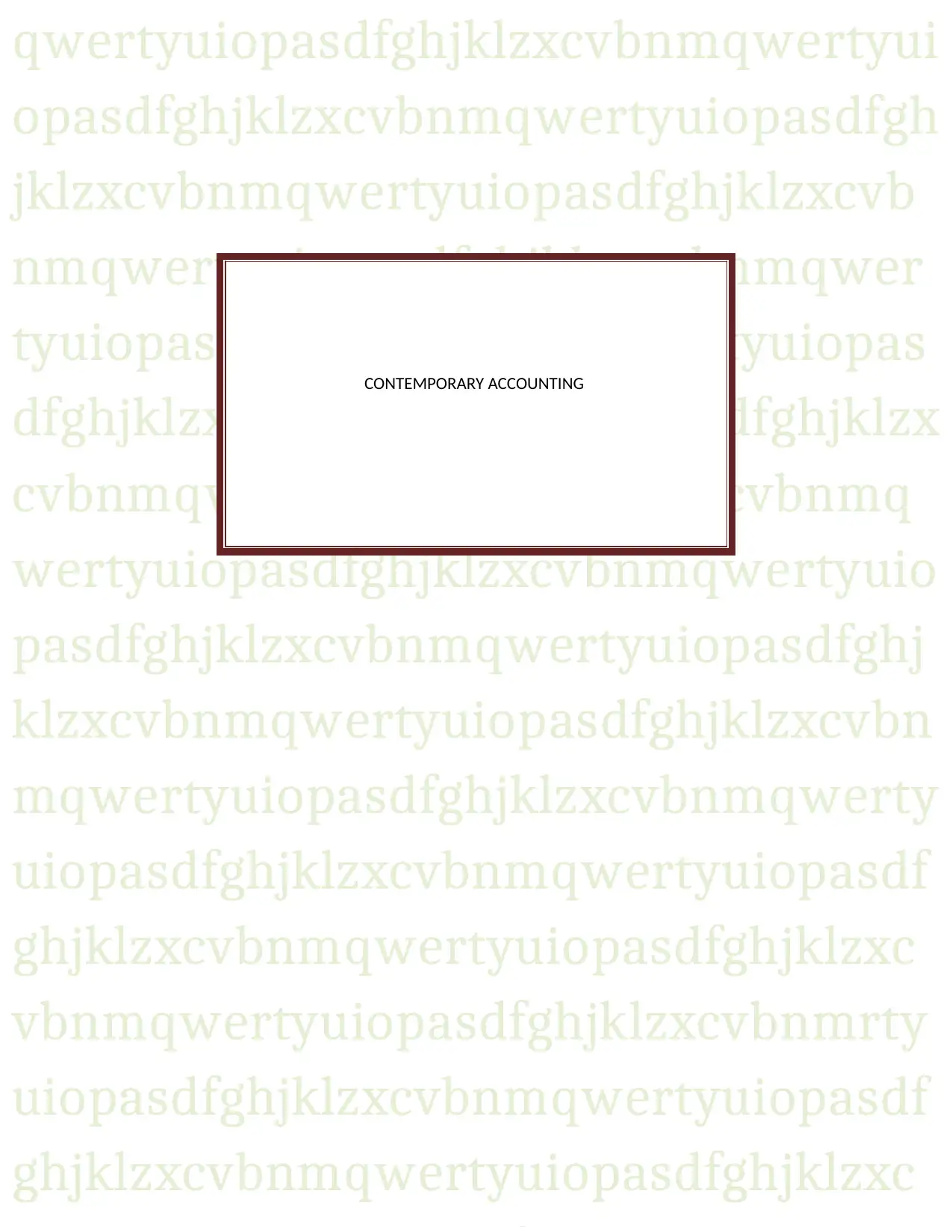
qwertyuiopasdfghjklzxcvbnmqwertyui
opasdfghjklzxcvbnmqwertyuiopasdfgh
jklzxcvbnmqwertyuiopasdfghjklzxcvb
nmqwertyuiopasdfghjklzxcvbnmqwer
tyuiopasdfghjklzxcvbnmqwertyuiopas
dfghjklzxcvbnmqwertyuiopasdfghjklzx
cvbnmqwertyuiopasdfghjklzxcvbnmq
wertyuiopasdfghjklzxcvbnmqwertyuio
pasdfghjklzxcvbnmqwertyuiopasdfghj
klzxcvbnmqwertyuiopasdfghjklzxcvbn
mqwertyuiopasdfghjklzxcvbnmqwerty
uiopasdfghjklzxcvbnmqwertyuiopasdf
ghjklzxcvbnmqwertyuiopasdfghjklzxc
vbnmqwertyuiopasdfghjklzxcvbnmrty
uiopasdfghjklzxcvbnmqwertyuiopasdf
ghjklzxcvbnmqwertyuiopasdfghjklzxc
CONTEMPORARY ACCOUNTING
opasdfghjklzxcvbnmqwertyuiopasdfgh
jklzxcvbnmqwertyuiopasdfghjklzxcvb
nmqwertyuiopasdfghjklzxcvbnmqwer
tyuiopasdfghjklzxcvbnmqwertyuiopas
dfghjklzxcvbnmqwertyuiopasdfghjklzx
cvbnmqwertyuiopasdfghjklzxcvbnmq
wertyuiopasdfghjklzxcvbnmqwertyuio
pasdfghjklzxcvbnmqwertyuiopasdfghj
klzxcvbnmqwertyuiopasdfghjklzxcvbn
mqwertyuiopasdfghjklzxcvbnmqwerty
uiopasdfghjklzxcvbnmqwertyuiopasdf
ghjklzxcvbnmqwertyuiopasdfghjklzxc
vbnmqwertyuiopasdfghjklzxcvbnmrty
uiopasdfghjklzxcvbnmqwertyuiopasdf
ghjklzxcvbnmqwertyuiopasdfghjklzxc
CONTEMPORARY ACCOUNTING
Paraphrase This Document
Need a fresh take? Get an instant paraphrase of this document with our AI Paraphraser
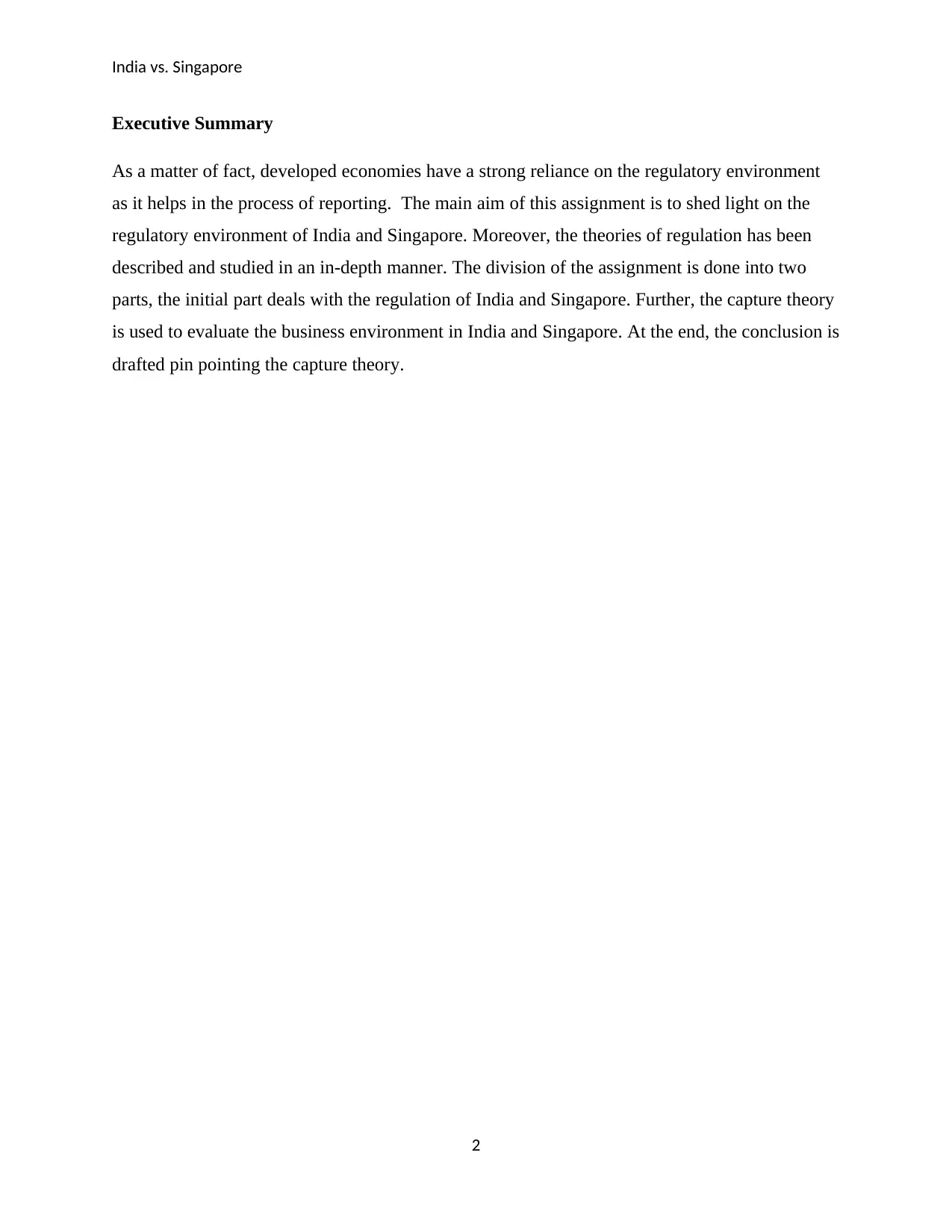
India vs. Singapore
Executive Summary
As a matter of fact, developed economies have a strong reliance on the regulatory environment
as it helps in the process of reporting. The main aim of this assignment is to shed light on the
regulatory environment of India and Singapore. Moreover, the theories of regulation has been
described and studied in an in-depth manner. The division of the assignment is done into two
parts, the initial part deals with the regulation of India and Singapore. Further, the capture theory
is used to evaluate the business environment in India and Singapore. At the end, the conclusion is
drafted pin pointing the capture theory.
2
Executive Summary
As a matter of fact, developed economies have a strong reliance on the regulatory environment
as it helps in the process of reporting. The main aim of this assignment is to shed light on the
regulatory environment of India and Singapore. Moreover, the theories of regulation has been
described and studied in an in-depth manner. The division of the assignment is done into two
parts, the initial part deals with the regulation of India and Singapore. Further, the capture theory
is used to evaluate the business environment in India and Singapore. At the end, the conclusion is
drafted pin pointing the capture theory.
2
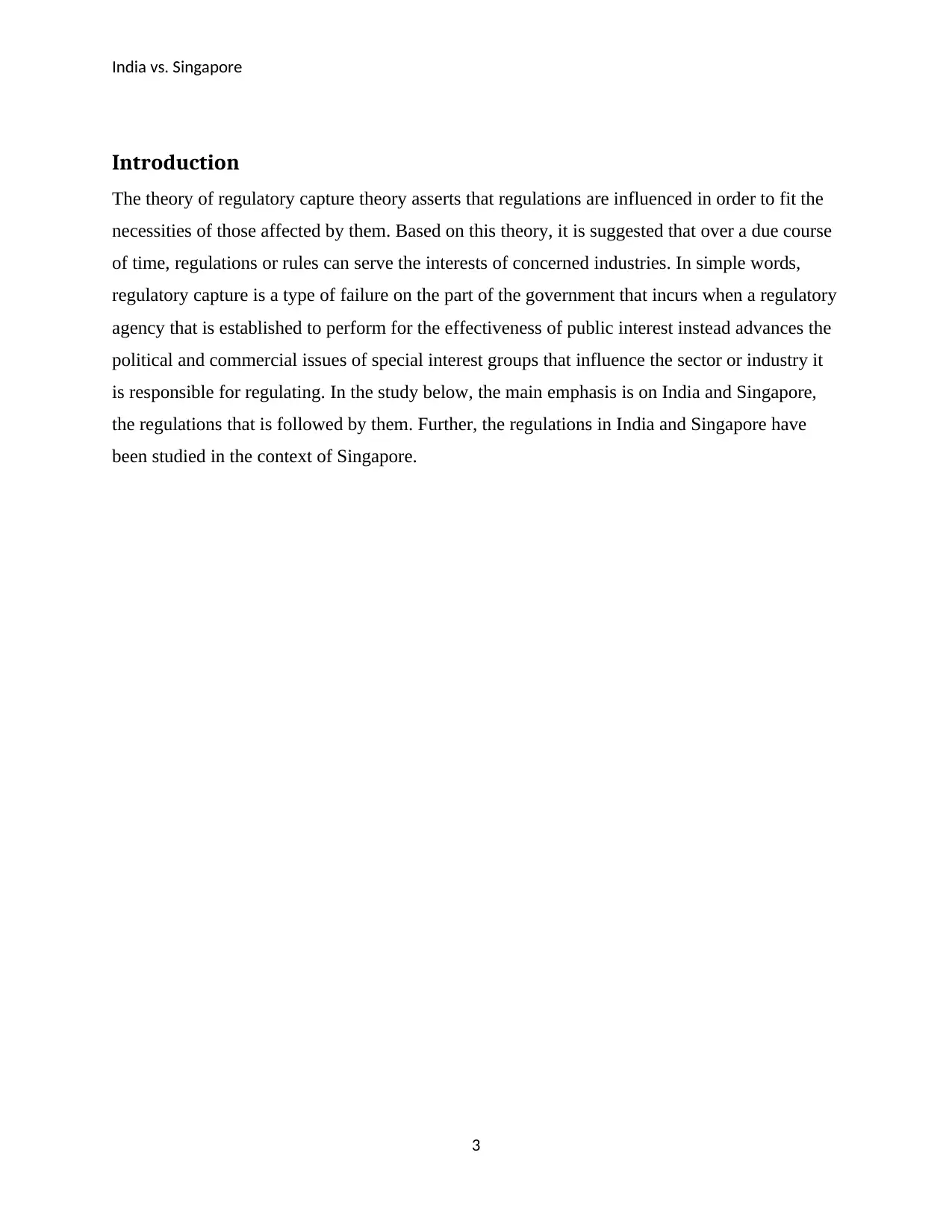
India vs. Singapore
Introduction
The theory of regulatory capture theory asserts that regulations are influenced in order to fit the
necessities of those affected by them. Based on this theory, it is suggested that over a due course
of time, regulations or rules can serve the interests of concerned industries. In simple words,
regulatory capture is a type of failure on the part of the government that incurs when a regulatory
agency that is established to perform for the effectiveness of public interest instead advances the
political and commercial issues of special interest groups that influence the sector or industry it
is responsible for regulating. In the study below, the main emphasis is on India and Singapore,
the regulations that is followed by them. Further, the regulations in India and Singapore have
been studied in the context of Singapore.
3
Introduction
The theory of regulatory capture theory asserts that regulations are influenced in order to fit the
necessities of those affected by them. Based on this theory, it is suggested that over a due course
of time, regulations or rules can serve the interests of concerned industries. In simple words,
regulatory capture is a type of failure on the part of the government that incurs when a regulatory
agency that is established to perform for the effectiveness of public interest instead advances the
political and commercial issues of special interest groups that influence the sector or industry it
is responsible for regulating. In the study below, the main emphasis is on India and Singapore,
the regulations that is followed by them. Further, the regulations in India and Singapore have
been studied in the context of Singapore.
3
⊘ This is a preview!⊘
Do you want full access?
Subscribe today to unlock all pages.

Trusted by 1+ million students worldwide
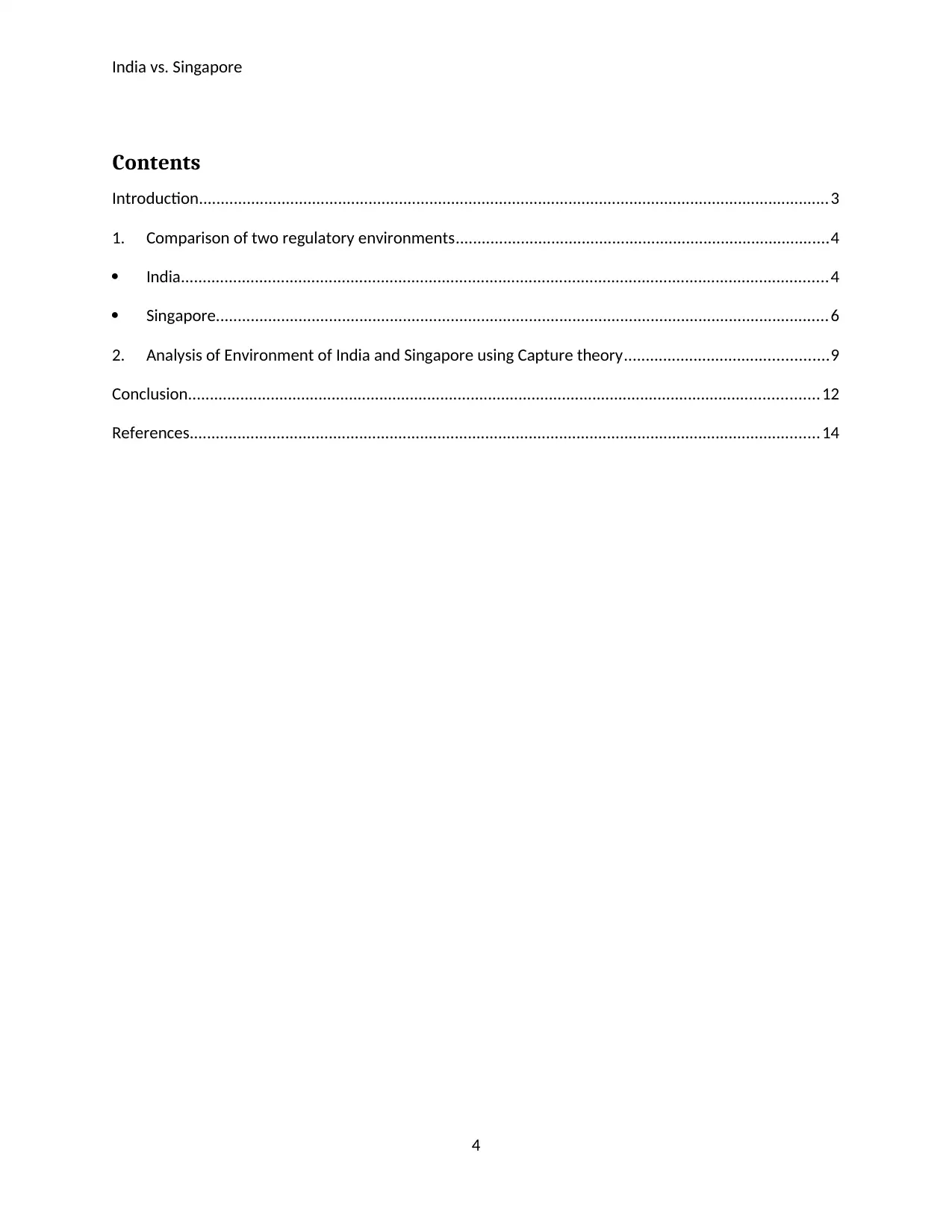
India vs. Singapore
Contents
Introduction.................................................................................................................................................3
1. Comparison of two regulatory environments......................................................................................4
India.....................................................................................................................................................4
Singapore.............................................................................................................................................6
2. Analysis of Environment of India and Singapore using Capture theory...............................................9
Conclusion.................................................................................................................................................12
References.................................................................................................................................................14
4
Contents
Introduction.................................................................................................................................................3
1. Comparison of two regulatory environments......................................................................................4
India.....................................................................................................................................................4
Singapore.............................................................................................................................................6
2. Analysis of Environment of India and Singapore using Capture theory...............................................9
Conclusion.................................................................................................................................................12
References.................................................................................................................................................14
4
Paraphrase This Document
Need a fresh take? Get an instant paraphrase of this document with our AI Paraphraser
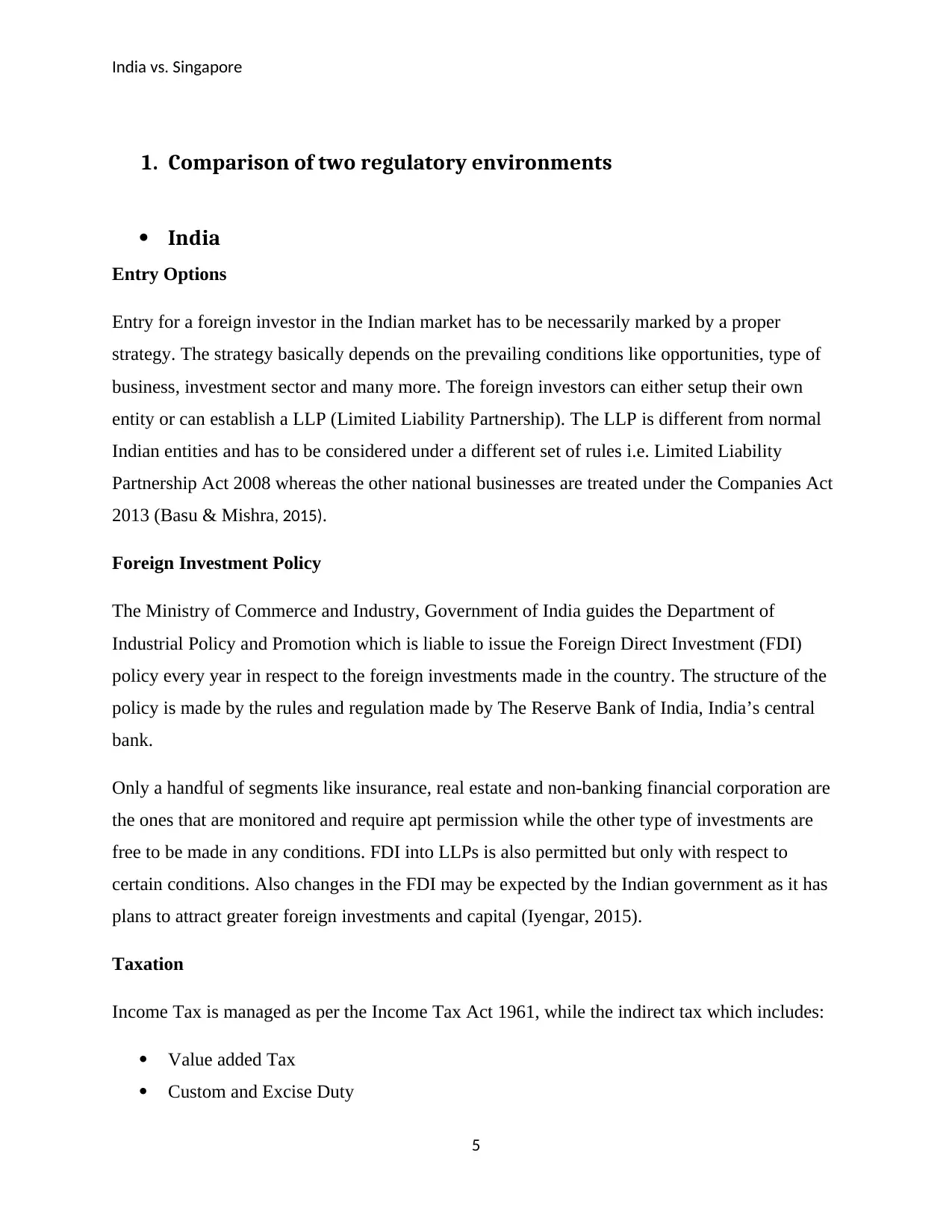
India vs. Singapore
1. Comparison of two regulatory environments
India
Entry Options
Entry for a foreign investor in the Indian market has to be necessarily marked by a proper
strategy. The strategy basically depends on the prevailing conditions like opportunities, type of
business, investment sector and many more. The foreign investors can either setup their own
entity or can establish a LLP (Limited Liability Partnership). The LLP is different from normal
Indian entities and has to be considered under a different set of rules i.e. Limited Liability
Partnership Act 2008 whereas the other national businesses are treated under the Companies Act
2013 (Basu & Mishra, 2015).
Foreign Investment Policy
The Ministry of Commerce and Industry, Government of India guides the Department of
Industrial Policy and Promotion which is liable to issue the Foreign Direct Investment (FDI)
policy every year in respect to the foreign investments made in the country. The structure of the
policy is made by the rules and regulation made by The Reserve Bank of India, India’s central
bank.
Only a handful of segments like insurance, real estate and non-banking financial corporation are
the ones that are monitored and require apt permission while the other type of investments are
free to be made in any conditions. FDI into LLPs is also permitted but only with respect to
certain conditions. Also changes in the FDI may be expected by the Indian government as it has
plans to attract greater foreign investments and capital (Iyengar, 2015).
Taxation
Income Tax is managed as per the Income Tax Act 1961, while the indirect tax which includes:
Value added Tax
Custom and Excise Duty
5
1. Comparison of two regulatory environments
India
Entry Options
Entry for a foreign investor in the Indian market has to be necessarily marked by a proper
strategy. The strategy basically depends on the prevailing conditions like opportunities, type of
business, investment sector and many more. The foreign investors can either setup their own
entity or can establish a LLP (Limited Liability Partnership). The LLP is different from normal
Indian entities and has to be considered under a different set of rules i.e. Limited Liability
Partnership Act 2008 whereas the other national businesses are treated under the Companies Act
2013 (Basu & Mishra, 2015).
Foreign Investment Policy
The Ministry of Commerce and Industry, Government of India guides the Department of
Industrial Policy and Promotion which is liable to issue the Foreign Direct Investment (FDI)
policy every year in respect to the foreign investments made in the country. The structure of the
policy is made by the rules and regulation made by The Reserve Bank of India, India’s central
bank.
Only a handful of segments like insurance, real estate and non-banking financial corporation are
the ones that are monitored and require apt permission while the other type of investments are
free to be made in any conditions. FDI into LLPs is also permitted but only with respect to
certain conditions. Also changes in the FDI may be expected by the Indian government as it has
plans to attract greater foreign investments and capital (Iyengar, 2015).
Taxation
Income Tax is managed as per the Income Tax Act 1961, while the indirect tax which includes:
Value added Tax
Custom and Excise Duty
5
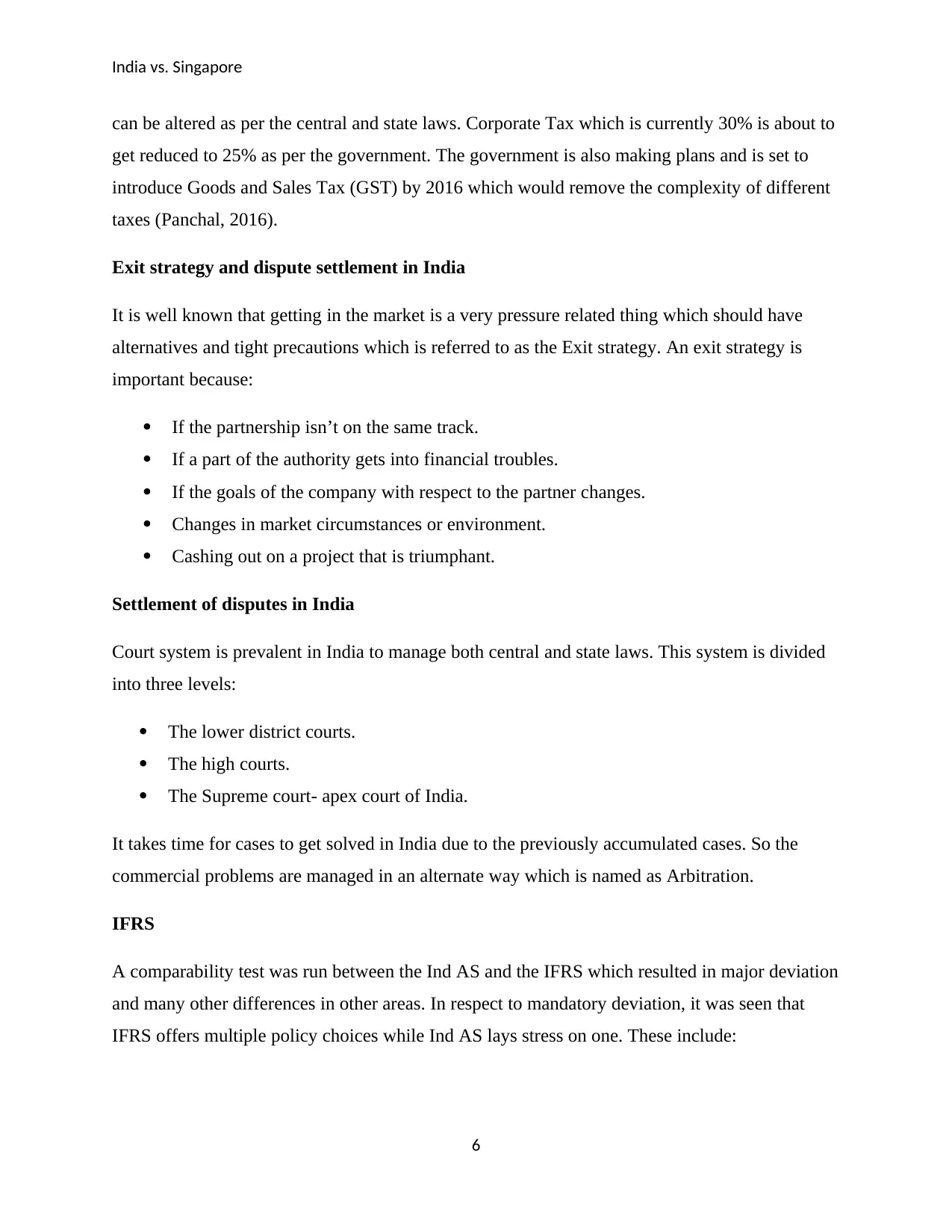
India vs. Singapore
can be altered as per the central and state laws. Corporate Tax which is currently 30% is about to
get reduced to 25% as per the government. The government is also making plans and is set to
introduce Goods and Sales Tax (GST) by 2016 which would remove the complexity of different
taxes (Panchal, 2016).
Exit strategy and dispute settlement in India
It is well known that getting in the market is a very pressure related thing which should have
alternatives and tight precautions which is referred to as the Exit strategy. An exit strategy is
important because:
If the partnership isn’t on the same track.
If a part of the authority gets into financial troubles.
If the goals of the company with respect to the partner changes.
Changes in market circumstances or environment.
Cashing out on a project that is triumphant.
Settlement of disputes in India
Court system is prevalent in India to manage both central and state laws. This system is divided
into three levels:
The lower district courts.
The high courts.
The Supreme court- apex court of India.
It takes time for cases to get solved in India due to the previously accumulated cases. So the
commercial problems are managed in an alternate way which is named as Arbitration.
IFRS
A comparability test was run between the Ind AS and the IFRS which resulted in major deviation
and many other differences in other areas. In respect to mandatory deviation, it was seen that
IFRS offers multiple policy choices while Ind AS lays stress on one. These include:
6
can be altered as per the central and state laws. Corporate Tax which is currently 30% is about to
get reduced to 25% as per the government. The government is also making plans and is set to
introduce Goods and Sales Tax (GST) by 2016 which would remove the complexity of different
taxes (Panchal, 2016).
Exit strategy and dispute settlement in India
It is well known that getting in the market is a very pressure related thing which should have
alternatives and tight precautions which is referred to as the Exit strategy. An exit strategy is
important because:
If the partnership isn’t on the same track.
If a part of the authority gets into financial troubles.
If the goals of the company with respect to the partner changes.
Changes in market circumstances or environment.
Cashing out on a project that is triumphant.
Settlement of disputes in India
Court system is prevalent in India to manage both central and state laws. This system is divided
into three levels:
The lower district courts.
The high courts.
The Supreme court- apex court of India.
It takes time for cases to get solved in India due to the previously accumulated cases. So the
commercial problems are managed in an alternate way which is named as Arbitration.
IFRS
A comparability test was run between the Ind AS and the IFRS which resulted in major deviation
and many other differences in other areas. In respect to mandatory deviation, it was seen that
IFRS offers multiple policy choices while Ind AS lays stress on one. These include:
6
⊘ This is a preview!⊘
Do you want full access?
Subscribe today to unlock all pages.

Trusted by 1+ million students worldwide
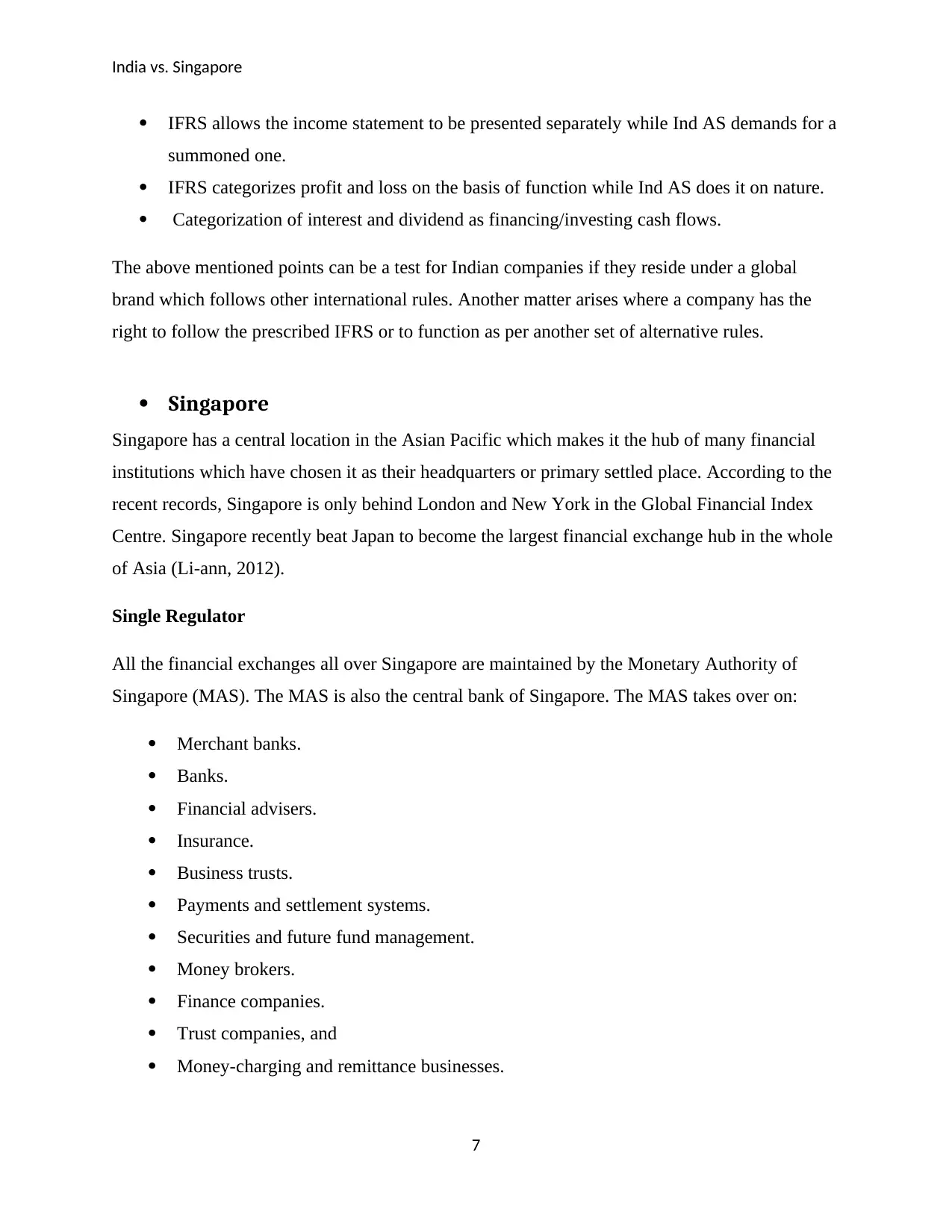
India vs. Singapore
IFRS allows the income statement to be presented separately while Ind AS demands for a
summoned one.
IFRS categorizes profit and loss on the basis of function while Ind AS does it on nature.
Categorization of interest and dividend as financing/investing cash flows.
The above mentioned points can be a test for Indian companies if they reside under a global
brand which follows other international rules. Another matter arises where a company has the
right to follow the prescribed IFRS or to function as per another set of alternative rules.
Singapore
Singapore has a central location in the Asian Pacific which makes it the hub of many financial
institutions which have chosen it as their headquarters or primary settled place. According to the
recent records, Singapore is only behind London and New York in the Global Financial Index
Centre. Singapore recently beat Japan to become the largest financial exchange hub in the whole
of Asia (Li-ann, 2012).
Single Regulator
All the financial exchanges all over Singapore are maintained by the Monetary Authority of
Singapore (MAS). The MAS is also the central bank of Singapore. The MAS takes over on:
Merchant banks.
Banks.
Financial advisers.
Insurance.
Business trusts.
Payments and settlement systems.
Securities and future fund management.
Money brokers.
Finance companies.
Trust companies, and
Money-charging and remittance businesses.
7
IFRS allows the income statement to be presented separately while Ind AS demands for a
summoned one.
IFRS categorizes profit and loss on the basis of function while Ind AS does it on nature.
Categorization of interest and dividend as financing/investing cash flows.
The above mentioned points can be a test for Indian companies if they reside under a global
brand which follows other international rules. Another matter arises where a company has the
right to follow the prescribed IFRS or to function as per another set of alternative rules.
Singapore
Singapore has a central location in the Asian Pacific which makes it the hub of many financial
institutions which have chosen it as their headquarters or primary settled place. According to the
recent records, Singapore is only behind London and New York in the Global Financial Index
Centre. Singapore recently beat Japan to become the largest financial exchange hub in the whole
of Asia (Li-ann, 2012).
Single Regulator
All the financial exchanges all over Singapore are maintained by the Monetary Authority of
Singapore (MAS). The MAS is also the central bank of Singapore. The MAS takes over on:
Merchant banks.
Banks.
Financial advisers.
Insurance.
Business trusts.
Payments and settlement systems.
Securities and future fund management.
Money brokers.
Finance companies.
Trust companies, and
Money-charging and remittance businesses.
7
Paraphrase This Document
Need a fresh take? Get an instant paraphrase of this document with our AI Paraphraser
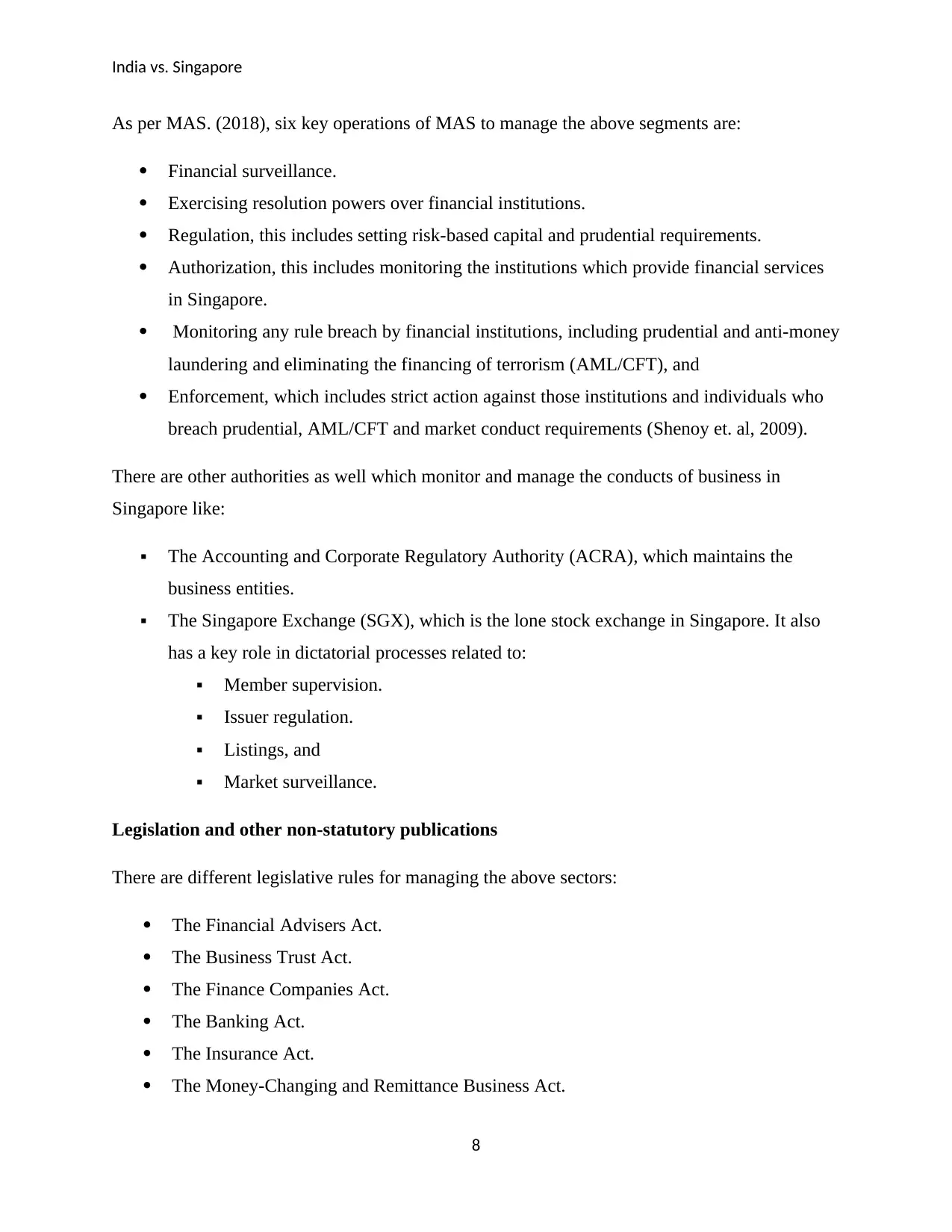
India vs. Singapore
As per MAS. (2018), six key operations of MAS to manage the above segments are:
Financial surveillance.
Exercising resolution powers over financial institutions.
Regulation, this includes setting risk-based capital and prudential requirements.
Authorization, this includes monitoring the institutions which provide financial services
in Singapore.
Monitoring any rule breach by financial institutions, including prudential and anti-money
laundering and eliminating the financing of terrorism (AML/CFT), and
Enforcement, which includes strict action against those institutions and individuals who
breach prudential, AML/CFT and market conduct requirements (Shenoy et. al, 2009).
There are other authorities as well which monitor and manage the conducts of business in
Singapore like:
The Accounting and Corporate Regulatory Authority (ACRA), which maintains the
business entities.
The Singapore Exchange (SGX), which is the lone stock exchange in Singapore. It also
has a key role in dictatorial processes related to:
Member supervision.
Issuer regulation.
Listings, and
Market surveillance.
Legislation and other non-statutory publications
There are different legislative rules for managing the above sectors:
The Financial Advisers Act.
The Business Trust Act.
The Finance Companies Act.
The Banking Act.
The Insurance Act.
The Money-Changing and Remittance Business Act.
8
As per MAS. (2018), six key operations of MAS to manage the above segments are:
Financial surveillance.
Exercising resolution powers over financial institutions.
Regulation, this includes setting risk-based capital and prudential requirements.
Authorization, this includes monitoring the institutions which provide financial services
in Singapore.
Monitoring any rule breach by financial institutions, including prudential and anti-money
laundering and eliminating the financing of terrorism (AML/CFT), and
Enforcement, which includes strict action against those institutions and individuals who
breach prudential, AML/CFT and market conduct requirements (Shenoy et. al, 2009).
There are other authorities as well which monitor and manage the conducts of business in
Singapore like:
The Accounting and Corporate Regulatory Authority (ACRA), which maintains the
business entities.
The Singapore Exchange (SGX), which is the lone stock exchange in Singapore. It also
has a key role in dictatorial processes related to:
Member supervision.
Issuer regulation.
Listings, and
Market surveillance.
Legislation and other non-statutory publications
There are different legislative rules for managing the above sectors:
The Financial Advisers Act.
The Business Trust Act.
The Finance Companies Act.
The Banking Act.
The Insurance Act.
The Money-Changing and Remittance Business Act.
8
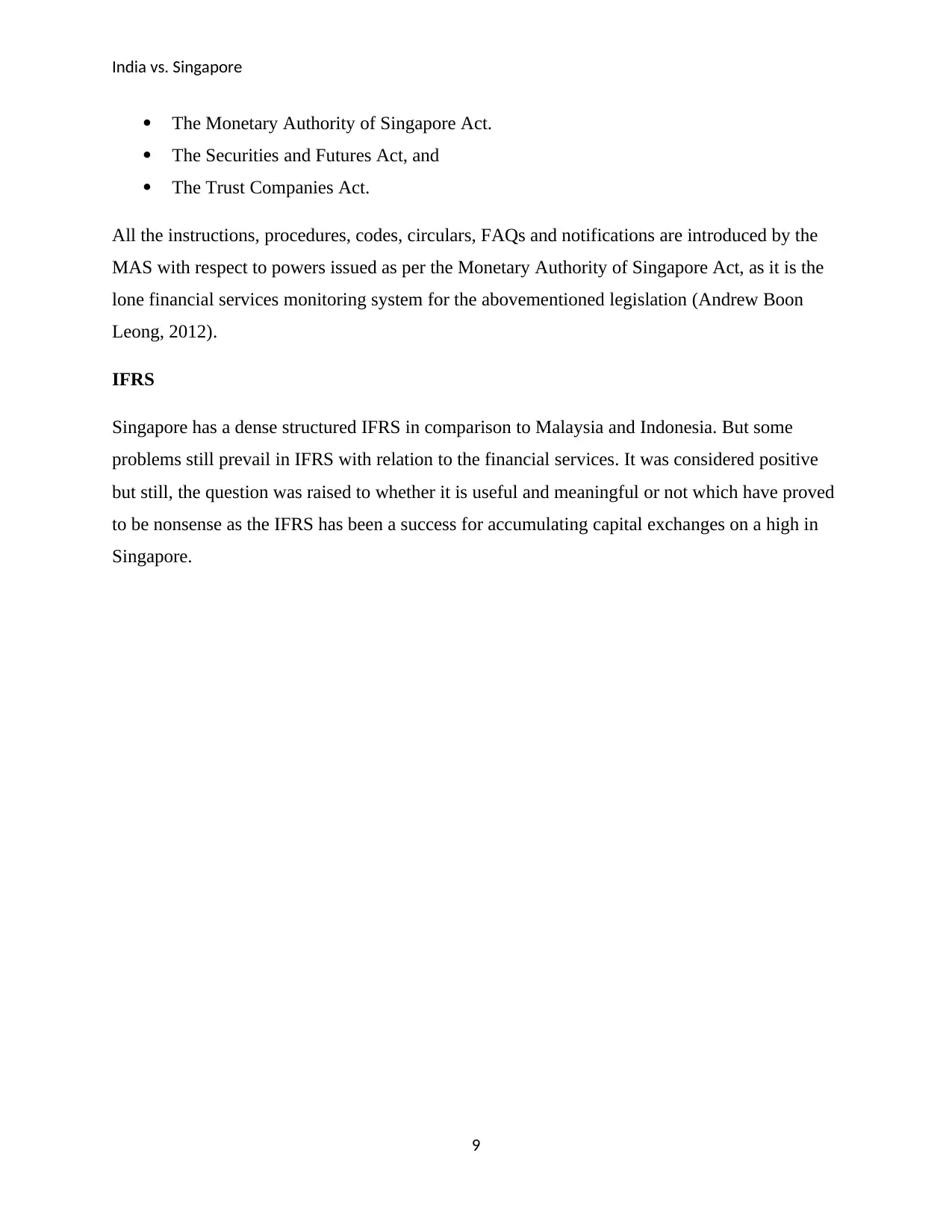
India vs. Singapore
The Monetary Authority of Singapore Act.
The Securities and Futures Act, and
The Trust Companies Act.
All the instructions, procedures, codes, circulars, FAQs and notifications are introduced by the
MAS with respect to powers issued as per the Monetary Authority of Singapore Act, as it is the
lone financial services monitoring system for the abovementioned legislation (Andrew Boon
Leong, 2012).
IFRS
Singapore has a dense structured IFRS in comparison to Malaysia and Indonesia. But some
problems still prevail in IFRS with relation to the financial services. It was considered positive
but still, the question was raised to whether it is useful and meaningful or not which have proved
to be nonsense as the IFRS has been a success for accumulating capital exchanges on a high in
Singapore.
9
The Monetary Authority of Singapore Act.
The Securities and Futures Act, and
The Trust Companies Act.
All the instructions, procedures, codes, circulars, FAQs and notifications are introduced by the
MAS with respect to powers issued as per the Monetary Authority of Singapore Act, as it is the
lone financial services monitoring system for the abovementioned legislation (Andrew Boon
Leong, 2012).
IFRS
Singapore has a dense structured IFRS in comparison to Malaysia and Indonesia. But some
problems still prevail in IFRS with relation to the financial services. It was considered positive
but still, the question was raised to whether it is useful and meaningful or not which have proved
to be nonsense as the IFRS has been a success for accumulating capital exchanges on a high in
Singapore.
9
⊘ This is a preview!⊘
Do you want full access?
Subscribe today to unlock all pages.

Trusted by 1+ million students worldwide
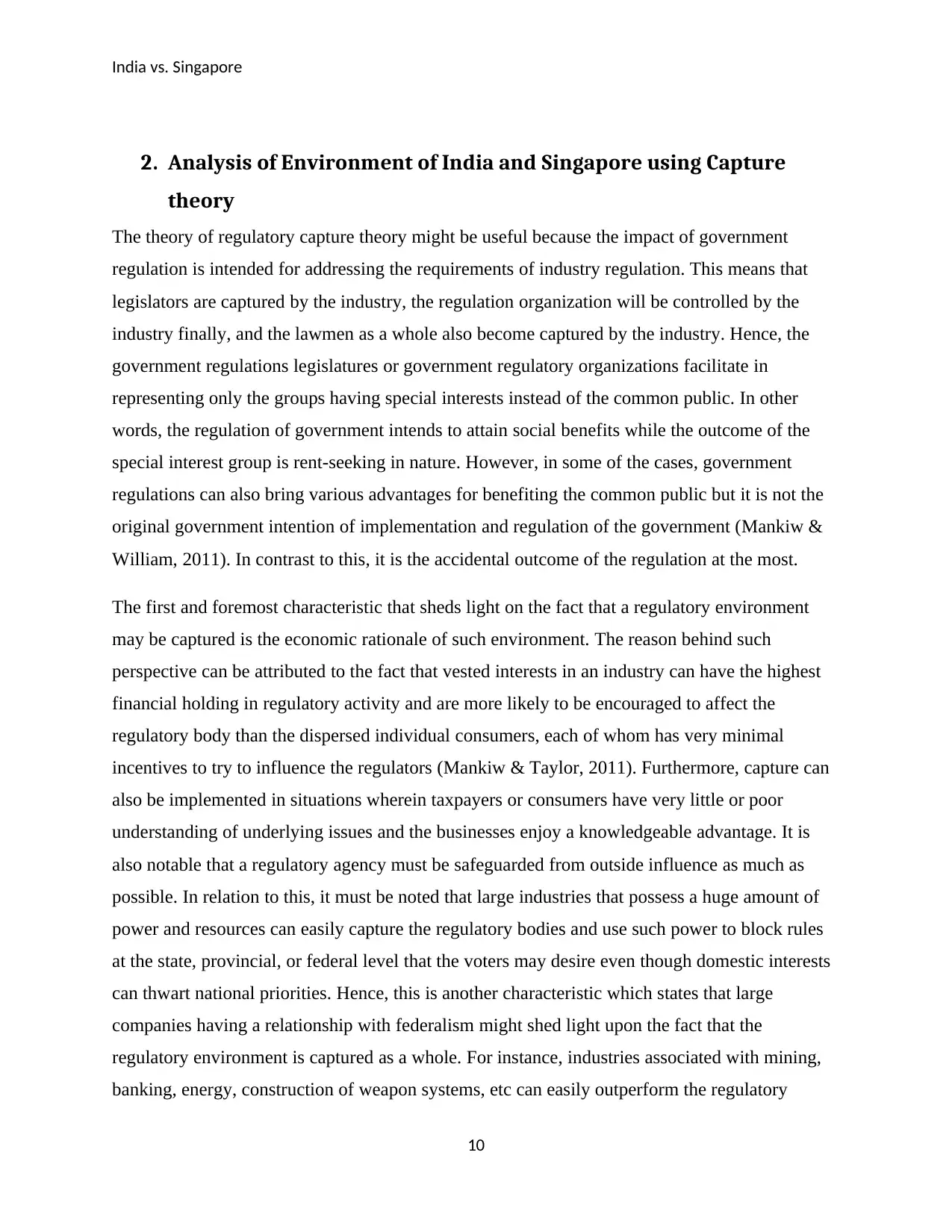
India vs. Singapore
2. Analysis of Environment of India and Singapore using Capture
theory
The theory of regulatory capture theory might be useful because the impact of government
regulation is intended for addressing the requirements of industry regulation. This means that
legislators are captured by the industry, the regulation organization will be controlled by the
industry finally, and the lawmen as a whole also become captured by the industry. Hence, the
government regulations legislatures or government regulatory organizations facilitate in
representing only the groups having special interests instead of the common public. In other
words, the regulation of government intends to attain social benefits while the outcome of the
special interest group is rent-seeking in nature. However, in some of the cases, government
regulations can also bring various advantages for benefiting the common public but it is not the
original government intention of implementation and regulation of the government (Mankiw &
William, 2011). In contrast to this, it is the accidental outcome of the regulation at the most.
The first and foremost characteristic that sheds light on the fact that a regulatory environment
may be captured is the economic rationale of such environment. The reason behind such
perspective can be attributed to the fact that vested interests in an industry can have the highest
financial holding in regulatory activity and are more likely to be encouraged to affect the
regulatory body than the dispersed individual consumers, each of whom has very minimal
incentives to try to influence the regulators (Mankiw & Taylor, 2011). Furthermore, capture can
also be implemented in situations wherein taxpayers or consumers have very little or poor
understanding of underlying issues and the businesses enjoy a knowledgeable advantage. It is
also notable that a regulatory agency must be safeguarded from outside influence as much as
possible. In relation to this, it must be noted that large industries that possess a huge amount of
power and resources can easily capture the regulatory bodies and use such power to block rules
at the state, provincial, or federal level that the voters may desire even though domestic interests
can thwart national priorities. Hence, this is another characteristic which states that large
companies having a relationship with federalism might shed light upon the fact that the
regulatory environment is captured as a whole. For instance, industries associated with mining,
banking, energy, construction of weapon systems, etc can easily outperform the regulatory
10
2. Analysis of Environment of India and Singapore using Capture
theory
The theory of regulatory capture theory might be useful because the impact of government
regulation is intended for addressing the requirements of industry regulation. This means that
legislators are captured by the industry, the regulation organization will be controlled by the
industry finally, and the lawmen as a whole also become captured by the industry. Hence, the
government regulations legislatures or government regulatory organizations facilitate in
representing only the groups having special interests instead of the common public. In other
words, the regulation of government intends to attain social benefits while the outcome of the
special interest group is rent-seeking in nature. However, in some of the cases, government
regulations can also bring various advantages for benefiting the common public but it is not the
original government intention of implementation and regulation of the government (Mankiw &
William, 2011). In contrast to this, it is the accidental outcome of the regulation at the most.
The first and foremost characteristic that sheds light on the fact that a regulatory environment
may be captured is the economic rationale of such environment. The reason behind such
perspective can be attributed to the fact that vested interests in an industry can have the highest
financial holding in regulatory activity and are more likely to be encouraged to affect the
regulatory body than the dispersed individual consumers, each of whom has very minimal
incentives to try to influence the regulators (Mankiw & Taylor, 2011). Furthermore, capture can
also be implemented in situations wherein taxpayers or consumers have very little or poor
understanding of underlying issues and the businesses enjoy a knowledgeable advantage. It is
also notable that a regulatory agency must be safeguarded from outside influence as much as
possible. In relation to this, it must be noted that large industries that possess a huge amount of
power and resources can easily capture the regulatory bodies and use such power to block rules
at the state, provincial, or federal level that the voters may desire even though domestic interests
can thwart national priorities. Hence, this is another characteristic which states that large
companies having a relationship with federalism might shed light upon the fact that the
regulatory environment is captured as a whole. For instance, industries associated with mining,
banking, energy, construction of weapon systems, etc can easily outperform the regulatory
10
Paraphrase This Document
Need a fresh take? Get an instant paraphrase of this document with our AI Paraphraser
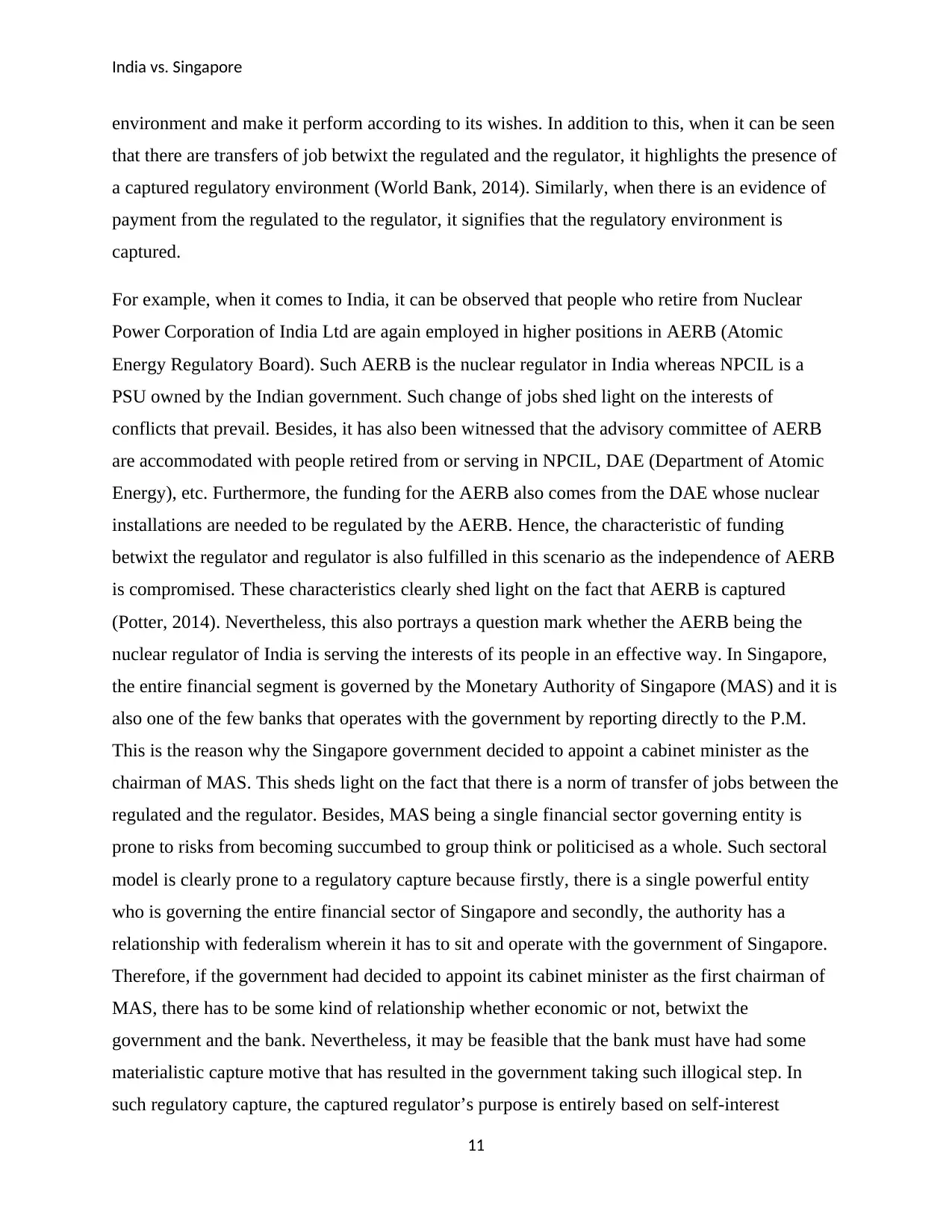
India vs. Singapore
environment and make it perform according to its wishes. In addition to this, when it can be seen
that there are transfers of job betwixt the regulated and the regulator, it highlights the presence of
a captured regulatory environment (World Bank, 2014). Similarly, when there is an evidence of
payment from the regulated to the regulator, it signifies that the regulatory environment is
captured.
For example, when it comes to India, it can be observed that people who retire from Nuclear
Power Corporation of India Ltd are again employed in higher positions in AERB (Atomic
Energy Regulatory Board). Such AERB is the nuclear regulator in India whereas NPCIL is a
PSU owned by the Indian government. Such change of jobs shed light on the interests of
conflicts that prevail. Besides, it has also been witnessed that the advisory committee of AERB
are accommodated with people retired from or serving in NPCIL, DAE (Department of Atomic
Energy), etc. Furthermore, the funding for the AERB also comes from the DAE whose nuclear
installations are needed to be regulated by the AERB. Hence, the characteristic of funding
betwixt the regulator and regulator is also fulfilled in this scenario as the independence of AERB
is compromised. These characteristics clearly shed light on the fact that AERB is captured
(Potter, 2014). Nevertheless, this also portrays a question mark whether the AERB being the
nuclear regulator of India is serving the interests of its people in an effective way. In Singapore,
the entire financial segment is governed by the Monetary Authority of Singapore (MAS) and it is
also one of the few banks that operates with the government by reporting directly to the P.M.
This is the reason why the Singapore government decided to appoint a cabinet minister as the
chairman of MAS. This sheds light on the fact that there is a norm of transfer of jobs between the
regulated and the regulator. Besides, MAS being a single financial sector governing entity is
prone to risks from becoming succumbed to group think or politicised as a whole. Such sectoral
model is clearly prone to a regulatory capture because firstly, there is a single powerful entity
who is governing the entire financial sector of Singapore and secondly, the authority has a
relationship with federalism wherein it has to sit and operate with the government of Singapore.
Therefore, if the government had decided to appoint its cabinet minister as the first chairman of
MAS, there has to be some kind of relationship whether economic or not, betwixt the
government and the bank. Nevertheless, it may be feasible that the bank must have had some
materialistic capture motive that has resulted in the government taking such illogical step. In
such regulatory capture, the captured regulator’s purpose is entirely based on self-interest
11
environment and make it perform according to its wishes. In addition to this, when it can be seen
that there are transfers of job betwixt the regulated and the regulator, it highlights the presence of
a captured regulatory environment (World Bank, 2014). Similarly, when there is an evidence of
payment from the regulated to the regulator, it signifies that the regulatory environment is
captured.
For example, when it comes to India, it can be observed that people who retire from Nuclear
Power Corporation of India Ltd are again employed in higher positions in AERB (Atomic
Energy Regulatory Board). Such AERB is the nuclear regulator in India whereas NPCIL is a
PSU owned by the Indian government. Such change of jobs shed light on the interests of
conflicts that prevail. Besides, it has also been witnessed that the advisory committee of AERB
are accommodated with people retired from or serving in NPCIL, DAE (Department of Atomic
Energy), etc. Furthermore, the funding for the AERB also comes from the DAE whose nuclear
installations are needed to be regulated by the AERB. Hence, the characteristic of funding
betwixt the regulator and regulator is also fulfilled in this scenario as the independence of AERB
is compromised. These characteristics clearly shed light on the fact that AERB is captured
(Potter, 2014). Nevertheless, this also portrays a question mark whether the AERB being the
nuclear regulator of India is serving the interests of its people in an effective way. In Singapore,
the entire financial segment is governed by the Monetary Authority of Singapore (MAS) and it is
also one of the few banks that operates with the government by reporting directly to the P.M.
This is the reason why the Singapore government decided to appoint a cabinet minister as the
chairman of MAS. This sheds light on the fact that there is a norm of transfer of jobs between the
regulated and the regulator. Besides, MAS being a single financial sector governing entity is
prone to risks from becoming succumbed to group think or politicised as a whole. Such sectoral
model is clearly prone to a regulatory capture because firstly, there is a single powerful entity
who is governing the entire financial sector of Singapore and secondly, the authority has a
relationship with federalism wherein it has to sit and operate with the government of Singapore.
Therefore, if the government had decided to appoint its cabinet minister as the first chairman of
MAS, there has to be some kind of relationship whether economic or not, betwixt the
government and the bank. Nevertheless, it may be feasible that the bank must have had some
materialistic capture motive that has resulted in the government taking such illogical step. In
such regulatory capture, the captured regulator’s purpose is entirely based on self-interest
11
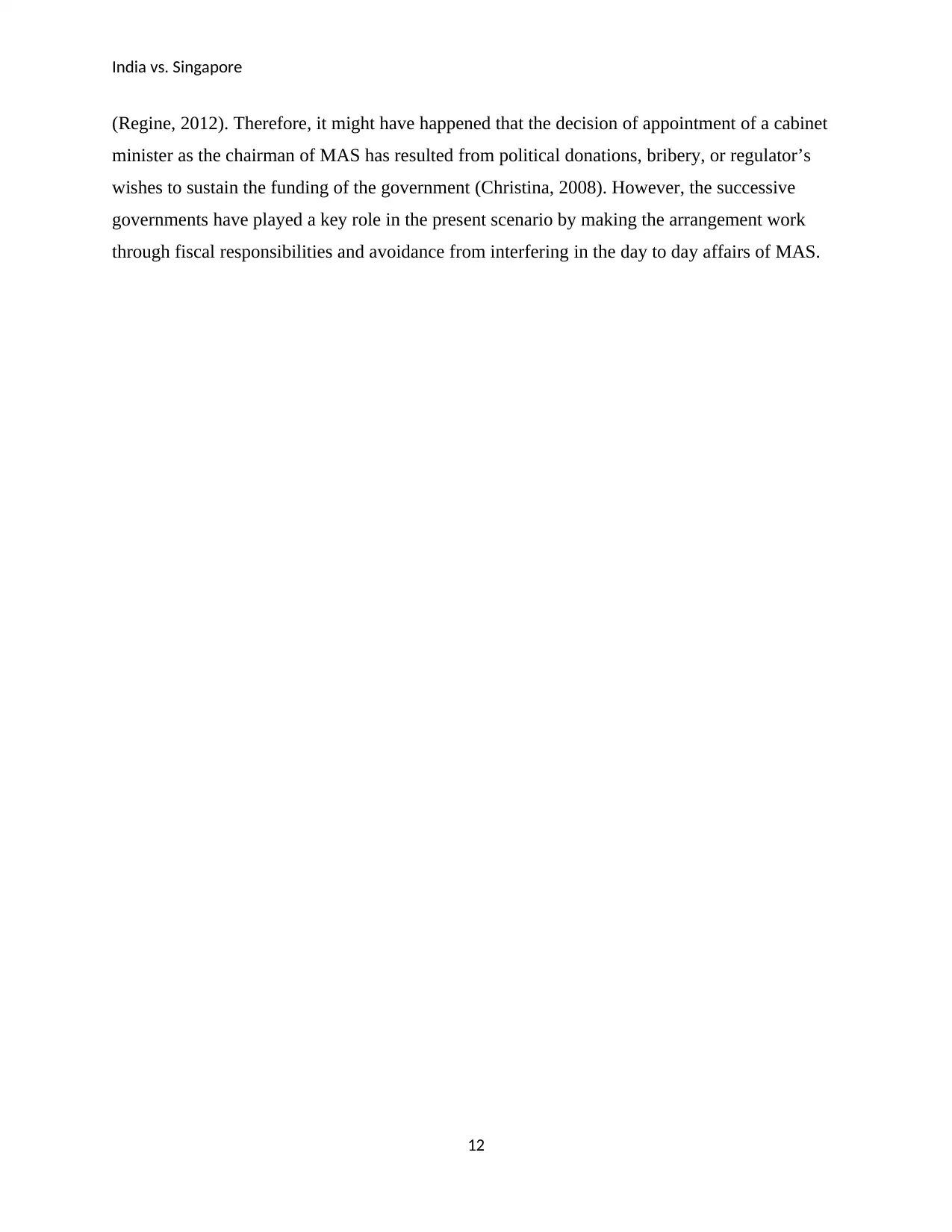
India vs. Singapore
(Regine, 2012). Therefore, it might have happened that the decision of appointment of a cabinet
minister as the chairman of MAS has resulted from political donations, bribery, or regulator’s
wishes to sustain the funding of the government (Christina, 2008). However, the successive
governments have played a key role in the present scenario by making the arrangement work
through fiscal responsibilities and avoidance from interfering in the day to day affairs of MAS.
12
(Regine, 2012). Therefore, it might have happened that the decision of appointment of a cabinet
minister as the chairman of MAS has resulted from political donations, bribery, or regulator’s
wishes to sustain the funding of the government (Christina, 2008). However, the successive
governments have played a key role in the present scenario by making the arrangement work
through fiscal responsibilities and avoidance from interfering in the day to day affairs of MAS.
12
⊘ This is a preview!⊘
Do you want full access?
Subscribe today to unlock all pages.

Trusted by 1+ million students worldwide
1 out of 16
Related Documents
Your All-in-One AI-Powered Toolkit for Academic Success.
+13062052269
info@desklib.com
Available 24*7 on WhatsApp / Email
![[object Object]](/_next/static/media/star-bottom.7253800d.svg)
Unlock your academic potential
Copyright © 2020–2025 A2Z Services. All Rights Reserved. Developed and managed by ZUCOL.





